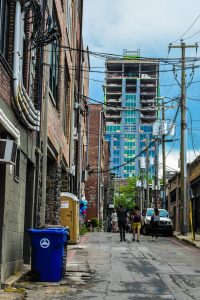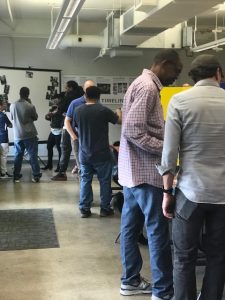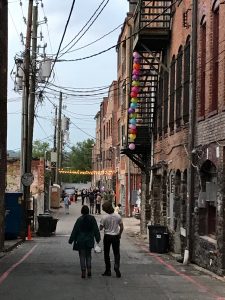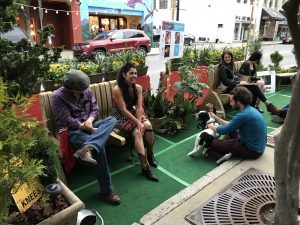
- What I’m Listening to – The chipper voice of the MAX light rail
- What I’m Reading – The Death and Life of Great American Cities – Jane Jacobs
- What I’m Watching – University of North Carolina basketball
- What I’m Doing – Enjoying a quiet Saturday
This post is part of ELGL’s “Creative Community” learning series about the role of arts and culture in local government. Sign up to guest blog about your local government experiences with creative placemaking here – tell your story so we can learn from you!
The role of creative placemaking in community visioning and civic engagement

“This is something Asheville has never seen before.”, my supervisor at the Asheville Design Center (ADC) proudly said to me. We had just wrapped up a creative placemaking event that explored creative ways to enhance and enliven underused downtown alleys.
Creative placemaking is the process of leveraging the arts to transform a community and improve quality of place.
These alleys were gritty, dirty, dark, and… remarkably interesting? Yes, they had served as centers of commerce in the days when chickens roamed the streets and people bought livestock downtown. They had been home to stables when fire engines were pulled by actual horses. They had served as the location for arts studios, short-term rentals, and even, in their even more neglected days, places of drug use and illicit activities.
If these streets could talk… What would they say?
Go where the people already are. Engage them there.
The Center for Craft (The Center), which backed up to these alleys, saw an opportunity to partner with ADC to facilitate the creation of a long-term vision for this district that addressed its physical, economic, and social deficiencies. The challenge was conducting the necessary public engagement process in a way that effectively involved the community. This required a new approach.
So, we put out public meeting notice signs. Just kidding; we didn’t do that.

We needed to be intentional in talking with marginalized communities. We needed to be intentional in engaging artists and creatives. We needed… help. So, from the very beginning, we recruited the supportive leadership of a local artist, Cortina Caldwell.
We took our conversations outside of City Hall, holding public meetings within the affected communities, making specific effort to go where usually overlooked members of the community gathered. We spoke one-on-one with individual property owners, business owners, and residents. We built partnerships with local organizations, and we brainstormed with the local university how we could include art students.
 The alley had new lighting, stages, popup shops, and temporary art installations throughout.
The alley had new lighting, stages, popup shops, and temporary art installations throughout.
But we knew we needed something more. We needed a way to try out these innovative ideas that were emerging and to gather feedback on their temporary implementation.
If these streets could talk… Well, perhaps they could.
We decided to plan an event that prototyped all of these ideas. In the urban planning field, this is known as tactical urbanism, experimenting with quick, low-cost activities as a way to gather data on potential long-term improvements. (It’s pretty fun.)
We wanted to give the streets a voice through offering feedback opportunities on stormwater infrastructure, public art, lighting, garbage, pocket parks and parklets, and even a temporary makerspace in the Center’s basement (as seen in the leading image for this article). To do this, we set up feedback stations throughout the alleys and added temporary elements of all of these things, and then put on the event which drew people into the alleys with music, art, lighting, and craft.

A parklet is a great way to extend the sidewalk for people, as seen by this temporary installation made out of turf, jersey barricades, planters, and benches.
If these streets could talk… What would we hear?
Over 1000 people attended the event, and almost 350 individual people provided direct feedback on the future of these alleys, specifically regarding their infrastructure and use of space. Our responses even matched the demographics of the city, which was unusual for many civic projects over the past several decades.
We learned that though these streets were not very active right now, people embraced the opportunity to bring new life to them once more through art, music, craft, and greenery, which is basically the definition of creative placemaking.
Kevin Teater is the executive director of the Beaverton (Oregon) Downtown Association and has been an ELGL member since 2017.
This blog is part of a new series called the Creative Community: a new content and learning partnership on creative placemaking! ELGL will work with ArtPlace America and Civic Arts to share content, learning opportunities, and resources about how to use art and culture to build and grow strong communities.
ELGL is calling this effort Creative Community because this is a project that welcomes everyone to participate. We know that when all local government departments – from public works to libraries, to budget offices (and everything in between) – use creative approaches, the result is stronger, more inclusive communities.
